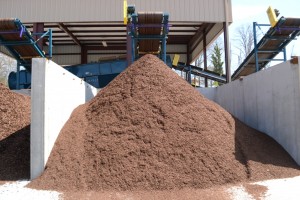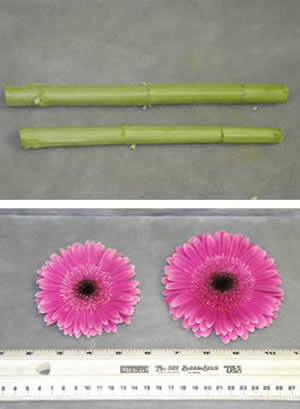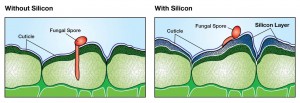Read everything that you need to know about horticultural silicon with this grower to Sun Gro technical specialist Q&A. Horticultural silicon is a water-soluble element that’s readily available to plants.
I’ve been hearing about silicon in plants and want to discuss the subject. Isn’t silicon ubiquitous?
True, silicon is the second most abundant element in the Earth’s crust, where surface soil exists. Plants growing in natural soil are constantly in contact with silicon. Of course, plants don’t indiscriminately take in all of the elements they encounter in soil; they take in elements selectively. Plants do naturally take in and accumulate silicon, which indicates they’re using it. In fact, most plants growing in natural soils take in as much silicon as common nutrients essential for growth, like phosphorus, calcium, magnesium, sulfur. Some plant species take in more silicon than even nitrogen and potassium!

Figure 1: Silicon is the second most abundant element in the Earth’s crust, so not surprisingly plants growing in natural soils have evolved to absorb and use silicon to their benefit.
What about silicon in potting media? Aren’t some potting media components, like sand, perlite, vermiculite, silicon-based?
Virtually no container grower uses natural topsoil in potting media anymore. Container growers use soilless media that’s mostly made of organic materials like peat, bark, coir, etc. These organic materials have hardly any minerals, let alone silicon. Although sand, pumice, perlite, vermiculite, rockwool are technically silicon materials, silicon from these materials is barely available to plants. In fact, silicon content in the plants growing in these soilless media is remarkably lower compared to the same plant species growing in natural soil.
Are my plants deprived of silicon when grown in soilless media?
Yes, compared to the natural world, where silicon is the norm in natural soil and where silicon is an integral part of natural plants, lack of silicon in soilless growing media and in turn plants growing in such media are artifacts and not entirely normal plants!
I’ve been growing plants alright in soilless media without silicon. Is it really needed?

Silicon got neglected— although unknowingly— during the historical and gradual transition from using all field soil to some field soil to completely soilless media in containers. That you can grow plants without silicon didn’t help either in silicon getting any attention. Silicon is not essential to plants, meaning plants can grow, flower and finish their life without silicon. You don’t see any obvious symptoms on plants when silicon is deficient, so you don’t pay any attention to silicon. Silicon is a beneficial element. It is similar to fluoride for our teeth. Fluoride is not essential for humans, but fluoride is beneficial in that it strengthens tooth enamel making it less vulnerable to cavities.
Does silicon strengthen plants? Does it have other benefits?
In nature, plants have evolved to absorb and use silicon to become not just structurally but also biochemically strong. Plants use silicon to cope with a variety of adverse conditions they encounter— such as pest attacks, strong winds, water shortages, toxic elements, etc. Think of plant using silicon to build a more solid house for itself against the huffs and puffs of adversaries!
What actually happens when silicon is available to the plants?

Plant roots take in silicon that is in the form of silicic acid and transport majority of it to the shoot along with the water stream. Along the way, some silicic acid is deposited in the roots and some in the xylem in the shoot. After reaching leaves, silicic acid is deposited in the walls of epidermal cells, just beneath the cuticle. As water is lost through transpiration, silicic acid concentrates and polymerizes to
solid silica gel. This results in the formation of a double layer of cuticle-silicon. The solid silica gel bodies are called phytoliths or plant opals, as they give toughness to plant tissues. In fact, fossilized phytoliths are what archeologists find years later and use to identify what kind of plants existed at a site!
Does the double layer of cuticle-silicon in plants act as armor?
Yes, to enter into a plant, fungal spores or insects have to puncture and penetrate the plant surface or cuticle first. When there is a silicon-reinforced barrier there, the resistance to the puncture increases and the progress of pest entry, in turn the incidence of pest attack decreases. The solidified silicon wears off mandibles of insect larva when they chew plant tissue, thereby limiting plant damage by insects.
You mentioned silicon protects plants biochemically, too. How?

Right, solidified silicon acting as an armor is not the whole story in silicon’s role in protecting the plants. When pathogen fungal spores attempt to penetrate the leaf, the fraction of silicon that’s still in solution form there— that’s silicic acid not yet solidified— triggers the synthesis of organic defense compounds within the plant by the plant itself. These compounds also obviate the fungal infection process. For this kind of protection, silicon in the plant should be in the form of silicic acid during the pest attack, because silicon that’s already solidified cannot reverse back to silicic acid. Solidified silicon within the plant cannot move from one location to another either— thus, a continuous availability of silicon is needed for growing plant tissues.
How do silicon-reinforced plants compare to those grown in standard mixes?
Yes, in nature, plants don’t want to collapse. In nature, plants absorb, deposit and solidify silicon in cell walls to gain structural rigidity so as to be erect and strong and resist falling during strong winds. The same effect of strong stems translates to fewer branch breaks during handling and shipping of your container plants, which are often top heavy. Such strong stems also help in cut flowers not being bent in floral arrangements. In nature, silicon-solidified stiff leaves hold wide and intercept and capture more light. Such an effect counteracts straggly plants with soft, droopy leaves, which often occur from the use of high nitrogen fertilizers in greenhouse plants. The silicon layer formed below the cuticle in leaves acts as a barrier against water loss from transpiration through cuticle. This effect reduces withering of leaves and prolongs the shelf life of container plants at retail stores.
Are there any other positive effects from silicon?
Silicon has such diverse effects on plants that it’s difficult settle on just one effect of silicon in any plant species. Silicon mitigates toxicity from micronutrient metals like manganese, copper, zinc, iron and balances their levels in plants. For example, you may have seen ugly brown spots on foliage of ornamental plants— on pothos, palms, etc.— due to toxic accumulation of oxidized manganese, coming from high manganese bark mix or low pH in growing media. Silicon prevents the buildup of such spots of toxic concentrations of manganese by distributing manganese evenly, thereby suppressing the appearance of ugly spots on ornamental plants. Similarly, silicon prevents copper toxicity, which plants can encounter from composts, fungicides or ionization of irrigation water. You may even have seen a copper toxicity symptom in your growing and probably mistook it as iron deficiency— for instance, chlorosis on the leaves of petunias! Interestingly, silicon ameliorates true iron deficiency too, modulating iron in the plants under iron deficiency conditions, resulting in significantly greener leaves and slower senescence. Silicon also helps plants cope with high salinity or high EC by reducing the level of salts getting into the shoots by blocking salt flow through the roots. This effect is especially important if your irrigation water is not of high quality or you are recycling your water, which tends to have high salinity.
Based on research, are silicon benefits more obvious when plants face adverse conditions?
When the going gets rough, with silicon, plants get tough! As you perceived, effects of silicon are not so evident or muted when plants are growing under benign conditions, but the effects become more apparent when plants come under stress. Stress is a universal condition all organisms face, so like you, plants do face stress conditions in real world, even in commercial greenhouse growing. In response, when plants have access to silicon, they use silicon as needed, sometimes acquiring silicon only under stress and reacting adaptively to those stresses. Effects of silicon are realized even better when a stress develops gradually, approximating the stress plants encounter in nature.
Greenhouse-grown plants are always weaker than those grown outdoors. Could some of these growth differences be due to a silicon deficiency in plants grown in soilless media?
Observations on plants without and with silicon have been corroborated in laboratory experiments. In fact, such pragmatic observations on plants grown in the field soil versus in the soilless mixes in greenhouses are kindling the attention to silicon from greenhouse growers.
Can field-grown plants benefit from the addition of horticultural silicon?
It depends on soil type and attributes. For example, Florida farmers get positive responses in sugarcane quality when they apply silicon, and the application of silicon to rice is routine in Japan. This is because sugarcane in Florida is largely grown in the mucky soils of the Everglades, which are highly organic and silicon poor— just like your organic potting media. Likewise, Japanese rice farmers started using silicon long ago because they realized that their staple food crop— rice— wasn’t growing well without additional silicon due to the high organic matter in rice paddies. In either situation, adding sand to the soil would not help because silicon in this form is unavailable to plants.
Mineral soils may also benefit from applications of horticultural silicon. Native silicon, even in mineral soils, can be depleted due to continuous, repeated cropping. Of late, silicon applications are also becoming common in hydroponic crops, like cucumber, tomato, rose, etc.
Don’t some plants accumulate more silicon than others?
Yes, the amount of silicon accumulated varies not only among the crops, but even within the varieties of the same crop. Some varieties of rice accumulate silicon up to 10% of their dry weight. However, even 0.5% silicon in any plant is still similar to the percentages of essential nutrients like phosphorus, magnesium, sulfur. There are also differences among crops in their interaction with silicon. For example, there are variations in how much silicon is deposited in which plant organ (root, shoot, leaves, flowers, bracts, etc.) and where in the organ (lower leaves, upper leaves, lower or upper surface of a leaf, edges or middle of a leaf, etc.). The form (size, shape, texture) of silica structures or opal phytoliths formed among plants is also diverse. Uptake of silicon by plants differs under different conditions (summer versus winter). Such intrinsic differences in silicon accumulation patterns in turn influence the effects of silicon in various plants to various degrees under various conditions. Thus, less silicon in a plant doesn’t mean it is less effective functionally or less beneficial. For instance, lettuce accumulates little silicon (0.05%) but still just that much silicon somehow alleviates manganese toxicity, a plague in heading of lettuce. What exact role silicon plays in all the plant species under what context is still not fully understood. As a university professor put it, the biochemistry of silicon is the proverbial riddle wrapped in a mystery inside an enigma!
Though we don’t yet understand the dynamics of silicon in plant life fully, I presume there would be some role for silicon in all the plants since there is no ‘no-silicon’ plant in nature! So far, the subject of silicon has been deficient in my mind and silicon has been deficient in my plants. Now, I want to insure all my plants have silicon available to them just as in nature. So, how can I provide silicon to plants growing in soilless potting mixes? Not through silicon chips, I presume!
Sorry, no luck recycling your old computer chips to provide silicon to the plants! Providing silicon effectively to the plants growing in soilless media is a significant challenge, which is another reason why use of silicon in soilless culture is hampered. Remember that silicon is abundant on the Earth, so not surprisingly there are many natural silicon compounds, as well as industrial byproducts. However, just because a compound has silicon in its name doesn’t mean it’s a suitable source for plants in soilless media. Similarly, a material that contains more silicon doesn’t mean it provides more silicon to plants. After all, we just learned that plants hardly obtain silicon from sand, which literally is silicon! If you want to evaluate a silicon source, remember labs don’t test for plant-available silicon routinely.
Providing silicon to plants through irrigation is complicated too. Silicon sources for such use are not stable and when mixed into a regular feed solution, precipitation and severe clogging of irrigation nozzles occur. Such a precipitation interaction occurring in the growing media can obstruct watering and drainage of the growing media.
Roots of plants growing in natural field soils explore large volume of soil for silicon. However, roots of plants growing in containers can explore just the media limited to the container. Thus, a silicon source in soilless media in containers should be sufficiently available for the plants in the containers. The source should be pure and free of contaminants. It should be consistent from batch to batch. It shouldn’t compromise physical and chemical qualities of the growing media. Of course, low cost helps. Such a silicon source already embedded in the growing media would be convenient, so you don’t need to change your existing practices of watering, fertilizing, etc. Promising efforts have been made to embed such a silicon source into soilless growing media. Discuss with your growing media supplier.
Well, with fluoride embedded toothpaste, there has been decline in tooth cavities. With silicon embedded soilless media, there would be a decline in damage to plants from pests and other stresses. With silicon integrated into soilless growing, plants growing in soilless media can emulate plants in nature in building up their inborn defenses. Such plants would need less pesticides and growth regulators based on University research. In our production of crops in soilless media, we desire such simple and natural practices.
Though the subject of silicon in plants still poses many fascinating questions, we’ve come a long way in our understanding of it and now there is enough evidence showing silicon benefits plants. So, silicon can now become an integral part of soilless growing technology and then, yes, plants in soilless culture can grow naturally— just like in nature!
(The views expressed here are not necessarily those of Sun Gro. A version of this article appeared in GrowerTalks May 2014.)
Silicon potting mix was one of the new products developed in the 1990s at the then Sun Gro R&D facility in Warwick (New York). Dr Shiv Reddy, along with the late Dr Paul King, developed and patented a novel soilless growing media that includes silicon. Dr Todd Cavins, who had researched silicon effects in greenhouse crop production at Oklahoma State, joined Sun Gro in 2005 and renewed the interest in silicon at Sun Gro.
Since those early days, numerous investigations at universities, government departments of agriculture across the world and 6 international conferences on silicon in agriculture plus symposiums, workshops show growing importance of silicon in plant life. All this evidence triggered the Association of American Plant Food Control Officials (AAPFCO) to look at silicon in a new way and designate and accept it as beneficial substance in 2012.
In 2013, the new management at Sun Gro, while reviewing the assets of Sun Gro, realizing the importance of silicon in horticultural growing, decided to update the silicon mix research at the current Sun Gro Discovery Centre for research in Anderson (South Carolina) and offer the product to the horticultural industry.
On the eve of this new product launch at Cultivate 14 in 2014, Shiv presents a thoughtful conversation, answering the questions that growers may have and perhaps they didn’t know they have!
If you have further questions, please contact a Sun Gro Technical Specialist.
